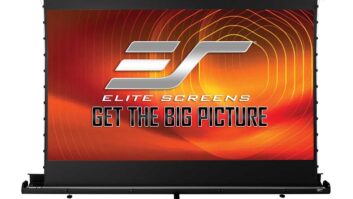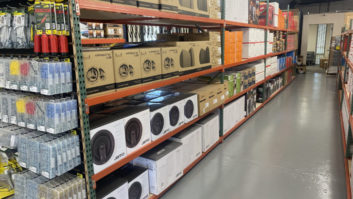NEW YORK —
Although flat-panel TVs continue
to dominate the U.S. home-theater marketplace,
manufacturers of front projectors are expecting renewed
growth in their categories this year as the
economy improves and new technologies bring new
excitement.
Currently, much of the new home-theater projector
market growth is being driven at both the entry end,
where applications for crossover business and hometheater
uses continues to bring customers into the big
box and online environments, and the high-end, where
well-heeled consumers continue to look for the latest
and greatest.
At the same time, established players at the low-end
are also moving upscale while some upscale manufacturers
are seeing more business from down-scaled
products, “so everything is kind of bleeding into the
middle,” observed Tamaryn Pratt, Quixel Research
principal.
“The market is really bifurcated right now,” she continued.
“On one end, there is demand for affordably
priced low-end products and specialized products like
Epson’s DVD/3LCD combi projector. At the other end,
there are companies like JVC, Sony, Sanyo and Runco
that are seeing activity at the middle of the market.”
According to Quixel market estimates made after
the third quarter of 2010, the total U.S. home-theater
front-projector market was expected to rise 32 percent
to 150,899 units for full year 2010, and should rise
another 3 percent this year to 155,346 units.
Manufacturers and analysts told TWICE that one
growth segment in the midrange is coming from models
with new light sources, like LED light systems that
don’t directly replace traditional projector sales.
“The reason is that this is mostly new business at
present,” said Jon Grodem, Optoma product marketing
senior director. “Also, we will see brightness improving
to create multiple segments in LED-based personal
portable projectors with price points in the $500 to
$700 range. We expect this segment to appeal strongly
to the mobile professional.”
Pratt said she was calling for a significant amount of
new business in the less-than-$1,500 1080p projector
segment, which has been driving consumers into
stores.
On the other hand, Runco, she pointed out, is doing
a good amount of business in down-scaled models (the
LS3 and LS7 series are the company’s biggest sellers)
and is also enjoying some business at the very high
end ($250,000 projector) level, working exclusively
through installers and A/V specialists.
Though the actual unit numbers may be small in comparison
to entry-level goods, Adam Schmidt, Runco
general manager and VP, said his company is expecting
a return to growth in the high-end in 2011.
“Runco has completely revamped its high-end offering
with a handful of new cinema projectors,” he said.
“This boom in the high-end segment is driven by the
growing — and currently largest ever — population of
high-net-worth-individuals in the world. There are more
than ever before. They have more of their wealth concentrated
in residential real estate than ever before,
and they are demanding top-of-the-line theaters and
cinemas for their homes.”
Runco rival Sim2 saw a similar trend and recently
took steps to emphasize upscale offerings and to move
away from less-profitable lower-priced goods.
Digital Projection, meanwhile, had a phenomenal
fourth quarter, Pratt said. The company saw good volume
playing closer to the entry end of the business,
without disrupting a good flow of product at the high
end in the Titan projector series.
At the lower end, meanwhile, companies like Vivitek,
Epson, Sanyo, Casio and Optoma are enjoying new opportunities
from advanced video gamers, mobile business
professionals and institutional/educational channels.
This, in turn, has encouraged more big-box electronics
retailers to add projector departments, said Rick
Nguyen, Vivitek general manager/senior VP.
“The projection category has been pretty stable the
last 10 years, but with new technologies such as 3D,
LED, integrated/interactive projectors, solid state and
2D-to-3D conversion, projectors are showing a new life
that retailers are finding exciting,” Nguyen continued.
Casio introduced its first projector based on a hybrid
LED/laser light source in January 2010, and “we
were very successful, having enjoyed a doubling of our
projector sales for our best year to date,” said Joseph
Gillio, Casio projector marketing director. “The projector
was positioned as the brightest bulb-less projector
in the market. He said the applications and target audiences
were wide ranging, and included strong sales in
the home theater and gaming markets.
Customers were attracted to the bright picture, rich
colors and low overall cost of ownership through the
use of a low-power light source, said Matt Mustachio,
Casio projector group general manager.
Epson enjoyed the second-best-selling projector
in the industry last year in its MovieMate DVD combi
model with 540p resolution and a $550 street retail,
said Quixel’s Pratt. A lot of consumers bought the
product for family movie nights in the back yard under
the stars, she observed.
Pratt said inexpensive models with 480p to 540p
resolution amounted to about 11 percent of category
sales in fourth quarter of 2010.
Despite the difficulty in presenting in-store demos,
big-box CE retailers and large regional chains were
selling projectors off the shelf or online, industry observers
said. Interestingly, channels like warehouse
clubs and discount department store chains have yet
to take off with the category.
“As users become more knowledgeable and technically
savvy, we see the need for live demos diminishing.
Buyers are researching using enhanced online content
and are then using informed decisions to buy. We are
seeing a strong synergy between online content and
in-store experience,” noted Optoma’s Grodem.
Much of the business is coming from crossover business
data projectors that can also be used in the home
theater on weekends, and from educational departments
looking for cheaper and cheaper products in a
time of constricting budgets.
One strong selling point here is high brightness
output (2,000 ANSI lumens and better for institutional
channels), and models that can handle 1080p HD
source material, for those times when the
projector is taken home or used to present
movies and special events in class rooms
and auditoriums.
With prices for 1080p HD starting at less
than $1,000 in some cases, some consumers
in big-screen sizes that can match the
value.
Newly emerging trends in the business include
models with wireless HDMI support
to easily facilitate wireless networking hookups
and easily move projectors from room to
room.
As for 3D, front-projector manufacturers
have a wide range of price points and performance
levels to choose from this year, reflecting
the general sentiment that 3D is yet
another opportunity for their technology to
shine.
“3D is done best big and projectors do big
best,” observed Grodem. “Home theater is
the natural fit for 3D. A second market [for
3D] is gaming … as the new gaming technology
moves in the players and consoles, fully
immersive huge images are exactly what is
wanted.”
“As content becomes more available and
as people experience good (and bad) 3D, it’s
clear that the best experience is an immersive
experience, in a home theater,” Runco’s
Schmidt pointed out. “A projector compromises
neither brightness, nor resolution, nor
comfort. Runco’s D-73 hits the mark on all
fronts, and the initial response to it has been
tremendous.”
“The future for 3D looks very promising,”
agreed Vivtek’s Nguyen. “Most of our data
projectors are currently 3D ready. We are
also launching a line of projectors that has
built-in 2D-to-3D technology (without an external
box). We’re being very aggressive with
our 3D product line in terms of technology
and price points.”











